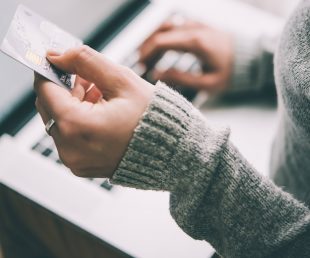You want to make managing your financial life easier. At the same time, you don’t want to compromise the safety of your personal information. Apple Pay combines the convenience you want with the security you need to make shopping as hassle-free as possible. If you’ve got questions about how Apple Pay works, we’ve got the answers.
What Is Apple Pay?
Apple Pay is Apple’s mobile payment system, which lets you make purchases using your iOS device. That includes the iPhone and iPad, as well as Apple Watch. You can use Apple Pay at millions of stores and it also works within selected apps and websites. It’s similar to Samsung Pay or Android Pay, but it’s exclusive to Apple users.
If you’ve got an Apple ID and a compatible device, setting up Apple Pay is as simple as adding your credit, debit or prepaid card information. You can add up to eight cards per device so you don’t have to lug around a wallet full of plastic. Apple Pay is supported by dozens of banks in the U.S., with new partners added regularly.
How Does Apple Pay Work?
Apple Pay is powered by near-field communication (NFC) technology. In simple tech-speak, near-field communication allows electronic devices to “talk” to each other to transmit data back and forth.
To make a purchase with Apple Pay in a store, you just hold your device next to the contactless payment terminal and tap Touch ID to pay. Your fingerprint confirms the purchase so there are no PIN numbers to remember. Your receipt is conveniently stored in the Wallet app for quick reference.
Is Apple Pay Secure?
This is the $64 million-dollar question and the short answer is yes. Understanding how Apple Pay security works takes a little more explanation, however.
When you add a debit or credit card to Apple Pay, your account information is encrypted and sent to Apple’s servers. Apple then links up with your bank to verify your information. The bank creates an encrypted Device Account Number that’s sent back to Apple and stored on the Secure Element in your device. This number is completely unique to your device and to the credit and debit cards associated with it.
When you make a purchase, the Secure Element (which is a security chip) creates a unique code and sends that, along with your Device Account Number, to the payment terminal in place of your card number. Your card information is never stored on your device or Apple’s servers and it’s never backed up to iCloud.
What Are the Benefits of Apple Pay?
Apple Pay can make shopping easier and less stressful if you’re worried about getting hit by a cyber attack. For one thing, it’s fast. Apple Pay streamlines the checkout process so you’re not wasting time at the register. You don’t have to fumble through your purse or wallet to find your credit card and there’s no receipt to sign once your purchase is complete.
In fact, you don’t have to carry your cards with you at all or keep up with different PINs. If you go out shopping and you leave your wallet at home, you wouldn’t be left stranded with no money as long as you’ve got your phone. Not having to carry your cards is also a benefit from a security standpoint.
If someone got their hands on your actual card, they could potentially use it to treat themselves to a shopping spree. If you were to lose your phone, on the other hand, it would be extremely difficult for someone to use it to make purchases or hack into your information if you’ve set up Touch ID using your fingerprint.
Another Apple Pay benefit is to shop more securely online. One of the biggest drawbacks of EMV chip cards is that you have to be able to “dip” the card into a chip reader terminal to get the added layer of security protection. You can’t do that when you’re shopping online so there’s no enhanced security benefit.
Essentially, it’s the same as swiping your card’s magnetic strip at the register. While there are security measures in place, reports of retail store point-of-sale system hackings are evidence that they’re not a perfect defense. When you shop within apps or pay on websites via Safari using Apple Pay, on the other hand, the same security checkpoints remain in place as if you were using it in a store.
Are There Any Downsides to Keep In Mind?
There’s a lot to like about Apple Pay but it’s not perfect. For one thing, not every merchant supports it. There’s no guarantee you’ll be able to use it if your favorite stores aren’t set up to accept contactless payments.
It’s also important to remember that no technology is foolproof. In March 2015, for instance, the Los Angeles Times reported that identity thieves were using stolen credit card numbers to commit fraud using Apple Pay. While Apple Pay cuts down on the risk of identity theft substantially, it doesn’t eliminate it altogether.
THE BOTTOM LINE
If you’re ready to take shopping hi-tech, Apple Pay may be just what you’re looking for. This quick guide covers the main highlights of how it works but like anything else, you should do your own research before diving in. That way, there are no surprises once you’re ready to begin using Apple Pay.



